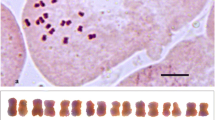Abstract
Cytotypes within the genera Seseli L. and Oenanthe L. show variation in chromosome number in pollen mother cells. A correlation of low chiasma frequency with meiotic irregularities and pollen sterility was noted. In addition to the meiotic irregularities in the two genera occurrence of polyspory and triple pollen formation during meiosis have been observed in Seseli diffusum (Roxb.) Sant. Wagh. The presence of different chromosome numbers in different populations of the same species and karyological investigation in 4 species of Oenanthe L. suggests that structural changes of chromosomes associated with numerical differences have possibly played a role in their evolution. Diminution in chromosome size and complete absence of metacentric chromosomes in Oenanthe lachenalli Gmel. suggest that probably this species is more evolved than 3 species of Oenanthe (i.e., O. benghalensis Benth., O. pimpinelloides L. and O. thomsoni Clarke). The interrelationships of the two genera are discussed.
Similar content being viewed by others
References
Arroyo, M. T. K., 1973. Chiasma frequency evidence on the evolution of autogamy in Limnanthes floccosa (Limnanthaceae). Evolution 27: 679–688.
Baksay, L., 1956. Cytotaxonomical studies on flora of Hungary. Annls hist. nat. Mus. natn. hung., Ser. nova, 7: 321–334.
Bohlmann, F., 1971. Acetylenic compounds in the Umbelliferae. In: The biology and chemistry of the Umbelliferae. Heywood, V. H., (ed.) Academic Press, London-New York, p 279–291.
Cauwet, A. M., 1968. Contribution à l'étude caryologique des ombellifères de la partie orientale des Pyrénées. Naturalia monspel. Ser. Bot. 19: 5–27.]
Cincura, F. & Hindakova, M., 1963. Pocty chromozomov a ich morfologia pri niektorych druhoch rodu Seseli L. 30 slovenskych nalezisk. Chromosomenzahlen und Morphologie der Chromosomen bei einigen Arten der Gattung Seséli L. aus slowakischen Fundorten. Biologia 18 (3): 184–194.
Courchet, L., 1882. Les ombellifères en général et les espèces usitées en pharmacie en particulier. 221 pp. Cristin, Serre & Ricome, Montpellier.
Drude, C. G. O., 1898. Umbelliferae. In: Engler, A. & Prantl, K. Die natürlichen Pflanzenfamilien 3 (8); 63–250.
Favarger, 1969. Notes de caryologie alphine V. Bull. Soc. neuchatel. Sci. nat 92: 13–30.
Federov, A. A., 1969. Chromosome numbers of flowering plants. Acad. Sci. U.S.S.R. Leningrad.
Fernandez, C. J., 1973. In: IOPB chromosome number reports XLII. Taxon 22: 647–654.
French, D. H., 1971. Ethnobotany of the Umbelliferae. In: The biology and chemistry of the Umbelliferae. Heywood (ed.) Academic Press London-New York, pp. 385–412.
Gardé, A. & Gardé, N., 1949. Contribuicão para o estudo cariologico de familia Umbelliferae. I.-Agronomia lusit. 11 (2): 9–140.
Gardé, A. & Gardé, N., 1954. Contribuicão para o estudo cariologico da familia Umbelliferae. III-Broteria 23 (1): 5–35.
Gurzenkov, N. N. & Gorovoy, P. G., 1971. Chromosome numbers of Umbelliferae of the Far East (in Russian). Bot. ZR., SSSR 56: 1805–1815.
Guyot, M., 1971. Phylogenetic and systematic value of stomata of the Umbelliferae. In. The biology and chemistry of the Umbelliferae, Heywood (ed.), Academic Press, London and New York, pp. 201–204.
Håkansson, A., 1953. Some chromosome numbers in Umbelliferae. Bot. Notiser: 301–307.
Heywood, V. H., 1971. Systematic survey of old world Umbelliferae. In: The biology and chemistry of the Umbelliferae. Heywood, V. H. (ed.). Academic Press, London-New York, p. 31–41.
Hooker, J. D., 1879. Flora of British India. Vol. II, pp. 693–697.
Hore, A. K., 1968. Chromosome number reports of plants. In: Annual Report, Cytogenetics Laboratory, Department of Botany, University of Calcutta. The Research Bulletin. Sarma, A. K. and Sarka, A. K. (eds.) 2: 38–48.
Hore, A. K., 1975. Karyomorphological studies of the genus Carum L. Indian Agric. 19 (3): 303–312.
Hore, A. K., 1976. Cytogenetical studies of the genus Foeniculum L. (Umbelliferae). Indian Agric. 20 (3): 183–191.
Hore, A., 1977a. An improved technique for the karyotype study of an economically important family, Umbelliferae. Curr. Sci. 46 (21): 751–752.
Hore, A., 1977b. Study of the structure and behaviour of chromosomes of different agricultural strains of Coriandrum sativum L. (Coriander). Caryologia 30 (4): 445–459.
Khoshoo, T. N., 1971. Hortorium taxonomy: Indian J. Genet. Pl. Breed. 31.
Larsen, K., 1954. Chromosome numbers of some European flowering plants. Bot. Tidsskr. 50 (2): 163–174.
Markova, M. & Robeva, P. N., 1972. In: IOPS Chromosome numbers report XXXVI. Taxon 21: 333–346.
Mitra, K. & Datta, N., 1967. In: IOPB Chromosome number reports XIII. Taxon 16: 445–461.
Moore, D. M., 1971. Chromosome numbers in Umbelliferae. In: The biology and chemistry of the Umbelliferae, Heywood, V.H. (ed.). Academic Press, London-New York, pp. 233–255.
Mulligan, C. W. J. & Grainger, N., 1972. In: IOPB Chromosome number reports. Taxon 21 (4): 495–500.
Quézel, P. & Contandriopoulos, J., 1965. Contribution à l'étude de la flore du Pinde central et septentrional et de l'Olympe de Thessalie. Candollea 20: 51–90.
Retina, T. A., Sdobnina, L. I. & Pimenov, M. T., 1977. Chromosome numbers of some species of the genus Seseli. Biol. Nauka (Moscow) 20 (1): 83–87.
Sharma, A. K. & Bhattacharyya, N. K., 1959. Further investigations on several genera of Umbelliferae and their interrelationships. Genetica 30 (1–2): 1–68.
Stebbins, G. L., 1971. Chromosomal evolution in higher plants. E. Arnold, London.
Susnik, F., 1967. Zur Chromosomenzahl einiger Pflanzensippen, E. (In Slovene) Biol. Vest. 10: 7–9.
Taylor, R. L. & Mulligan, G. A., 1968. Flora of the Queen Charlotte Islands. Part 2. Cytological aspect of the vascular plants. Queen's Printers, Ottawa, p. 148.
Yamashita, O. O., 1931. In: A list of chromosome numbers of plants cultivated in Japan-Chokobulsu Senshokutaisu no Kenkyu (Tokyo), eds. Kihara, H., Yamamoto Y. & Hosono S.: 193–330.
Author information
Authors and Affiliations
Rights and permissions
About this article
Cite this article
Hore, A. Cytotypes within the family Umbelliferae with special reference to the genera Seseli L. and Oenanthe L. (subtribe Seselinae). Genetica 56, 205–211 (1981). https://doi.org/10.1007/BF00057561
Received:
Accepted:
Issue Date:
DOI: https://doi.org/10.1007/BF00057561




